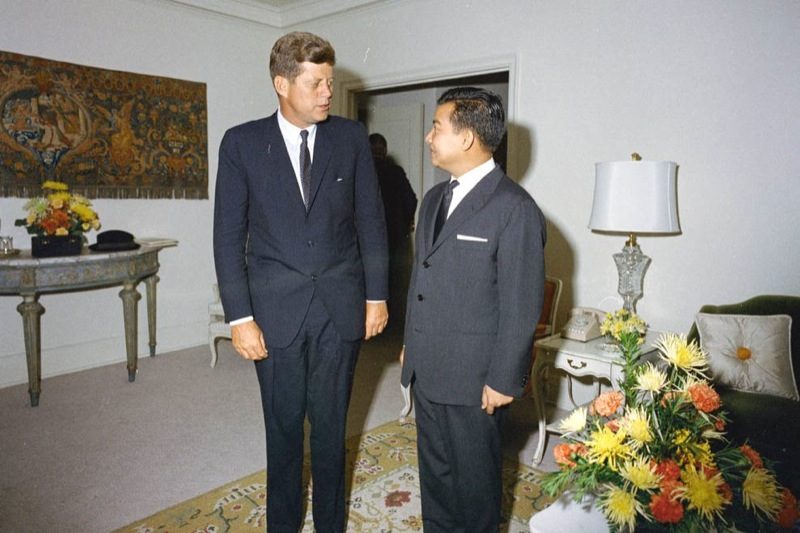Former U.S. President Richard Nixon was advised in 1969 to risk “embarrassment” in attempts to smooth diplomatic ties with Prince Norodom Sihanouk in order to further the U.S.’s interests in Cambodia, according to declassified files.
In a “top secret” memorandum for the president—one of about 12 million pages of documents the CIA released online last week—then U.S. Secretary of State William Rogers advises the president on how best to approach re-establishing diplomatic ties with Prince Sihanouk.

The U.S. Embassy in Phnom Penh had been closed since May 1965 due to Prince Sihanouk’s anger over border incursions and the U.S.’s attitude toward Cambodia more generally, said Raymond Leos, a law professor at Pannasastra University in Phnom Penh who is researching the era for an upcoming book.
“[Prince Sihanouk] was getting fed up with the growing number of border incidents involving South Vietnamese troops and American advisors, and he was also not happy at what he considered as the patronizing attitude toward him from the U.S. government and the American press,” he wrote in an email.
“But the root of it, of course, was his assessment of the current state of affairs in Indochina, and in particular, the escalating war in neighboring Vietnam. At about the same time Sihanouk broke relations with the U.S., the first detachment of American combat troops had landed ashore in South Vietnam.”
In the declassified document, Secretary Rogers argues that the U.S. would benefit from the re-establishment of diplomatic ties at a time when it was sure Cambodia was assisting the North Vietnamese Army (NVA) and Viet Cong (VC) militarily.
“NVA/VC use of Cambodian territory has increased. Recent evidence suggests strongly that Cambodia is indeed a major source of military supplies for VC/NVA forces in South Vietnam and that the supply route has a high degree of cooperation and connivance at high levels in the Cambodian government,” the document says.
“Even a small U.S. representation would give us some intelligence and information gains,” the report later states.
“If it progressed to the point where we had good military attaches there, with freedom to travel, we might in the end learn a great deal more—while the fact that we were watching might operate to tone down the supply activities now taking place through Cambodia.”
However, Secretary Rogers also outlines a number of potential problems that could scuttle efforts to re-establish a relationship.
“Our visible pursuit of a diplomatic course of action directed at easing our relations must, to a significant degree, inhibit any expansion in the authority our forces now have to act along the borders,” the report says, in apparent reference to military operations against Vietnamese communist forces.
Another potential snag was that Prince Sihanouk could go on a public relations warpath against the U.S.—something that could bring “embarrassment” to the superpower, it says.
“Under almost any circumstances, U.S. diplomatic representatives in Cambodia will experience some indignities,” Secretary Rogers warns.
“The Prince is bound to denounce us from time to time, and might in fact do this a bit more as a smokescreen for practical moves in our direction. We will need steady nerves, and will have to be prepared to live with some degree of embarrassment.”
The secretary of state later notes that the prince is “notorious for making everything he gets public” and was prone to waging personal vendettas.
“If our judgment is wrong or the particular events of the moment are unfavorable, he will take it out on you personally—although I must say that he will do this sooner or later in any event if he is in the mood,” it says.
An even bigger threat was the prospect of physical violence toward U.S. troops on the prince’s orders, it says, despite his moderate approach to recent “incidents”—including an “embarrassing one” in which a patrol destroyed a truck, killing eight Cambodian civilians.
“We simply cannot be sure that we can avoid some really major incident in which he would feel tempted to react,” it says, adding that Prince Sihanouk had already told the French ambassador that he would not treat U.S. representatives as “hostages.”
The possible ways to offer an olive branch to Prince Sihanouk were outlined to the president, ideally in a personal letter “merely expressing polite regards” to the prince.
“Such a letter would gratify Sihanouk and improve the prospects for, without involving you in the specific mechanisms of, a move toward resumption of relations,” it says.
Secretary Rogers once again reminds President Nixon of the possibility that the maverick prince will publicly throw it back in their faces.
“If of course the Prince ridicules your letter or otherwise displays a negative stance, then we stop in our tracks,” he writes. “I think our losses would be minor, and counterbalanced in many quarters by the visible evidence that we had tried.”
Relations eventually resumed on June 11, 1969, with the U.S. Embassy reopening on August 15, 1969.